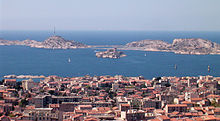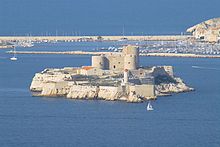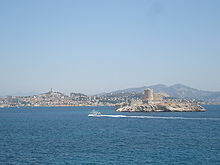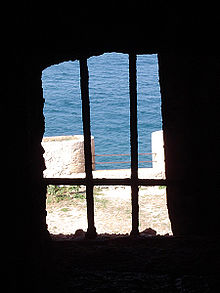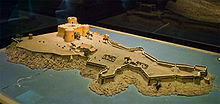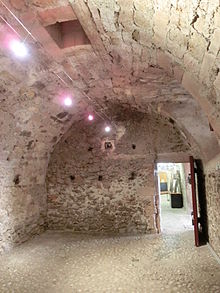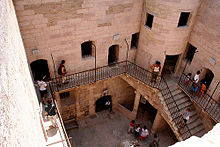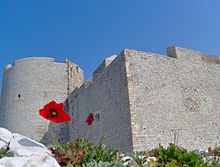- Château d'If
-
The Château d'If is a fortress (later a prison) located on the island of If, the smallest island in the Frioul Archipelago situated in the Mediterranean Sea about a mile offshore in the Bay of Marseille in southeastern France. It is famous for being one of the settings of Alexandre Dumas' adventure novel The Count of Monte Cristo.
The château is a square, three-story building 28 m long on each side, flanked by three towers with large gun embrasures. The remainder of the island, which only measures 30,000 square metres, is heavily fortified; high ramparts with gun platforms surmount the island's cliffs.
Contents
Fortress
The château was built in 1524-31 on the orders of King Francis I as a defence against attacks from the sea. However, its construction was extremely controversial. When Marseille was annexed to France in 1481, it retained the right to provide for its own defence. The castle was therefore seen by many of the local inhabitants as an unwanted imposition of central authority.
The castle's principal military value was as a deterrent; it never had to fight off an actual attack. The closest that it came to a genuine test of strength was in July 1531, when the Holy Roman Emperor Charles V made preparations to attack Marseille. However, he abandoned the invasion plan, perhaps deterred by the presence of the castle.
This was perhaps fortunate, given the weaknesses identified by the military engineer Vauban in a scathing report in 1701: "The fortifications look like the rock, they are fully rendered, but very roughly and carelessly, with many imperfections. The whole having been very badly built and with little care... All the buildings, very crudely done, are ill made."
After his assassination in Cairo in 1800, the embalmed body[1] of general Jean Baptiste Kléber was repatriated to France. Napoleon, fearing his tomb would become a symbol to Republicanism, ordered it to stay at the château. It remained there for 18 years until Louis XVIII granted a proper burial in his native Strasbourg.[2]
Prison
The isolated location and dangerous offshore currents of the Château d'If made it an ideal escape-proof prison, very much like the island of Alcatraz in California was in more modern times. Its use as a dumping ground for political and religious detainees soon made it one of the most feared and notorious jails in France. Over 3,500 Huguenots (French Protestants) were sent to If, as was Gaston Crémieux, a leader of the Paris Commune, who was shot there in 1871.
The island became internationally famous in the 19th century when Alexandre Dumas used it as a setting for The Count of Monte Cristo, published to widespread acclaim in 1844. In the book, the main character Edmond Dantès (a commoner who later purchases the noble title of Count) and his mentor, Abbé Faria, were both imprisoned in it. After fourteen years, Dantès makes a daring escape from the castle, becoming the first person ever to do so and survive. In reality, no one is known to have done this. The modern Château d'If maintains adjacent cells named after Dantès and Faria as a tourist attraction.
As was common practice in those days, prisoners were treated differently according to their class and wealth. The poorest were literally placed at the bottom, being confined to a windowless dungeon under the castle. The wealthiest were much better off, living comparatively comfortably in their own private cells (or pistoles) higher up, with windows, a garderobe and a fireplace. However, they were expected to pay for this privilege, effectively forcing them to fund their own incarceration.
The château today
The château's use as a prison ceased at the end of the 19th century. It was demilitarized and opened to the public on September 23, 1890. It can now be reached by boat from Marseille's old port. Its fame as the setting for Dumas' novel has made it a popular tourist destination.
Mark Twain visited the château in July, 1867 during a months long pleasure excursion. He recounts his visit in his book, The Innocents Abroad. He says a guide took his party into the prison, inside cells, and showed him the cell in which housed the "Iron Mask." This was prior to the château opening to the public. There is a sign at the château that says "Prison dite de l'Homme au Masque de Fer." This is likely only legend since the Man in the Iron Mask was never held at the Chateau d'If.
The Château d'If is listed as a monument historique by the French Ministry of Culture.
In fictional works
In the Tales of Old Dartmoor episode (recorded in 1956) of The Goons radio comedy series, Grytpype-Thynne arranges for Dartmoor Prison to put to sea to visit the Château d'If as part of a plan to find the treasure of the Count of Monte Cristo hidden there.
The fortress was used as the location where Alain Charnier a.k.a Frog One (Fernando Rey) meets Devereaux (Frédéric de Pasquale) to finalise the drugs shipment to the United States in the 1971 crime film The French Connection.
However other locations have been used for Château d'If in the retelling of Dumas' The Count of Monte Cristo. In the 2002 adaptation starring Jim Caviezel, the château was represented by St. Mary's Tower on Comino, the smallest Maltese island. The cliff-top watchtower can be seen from the ferry crossing between Malta and Gozo.
It is also used in the Clive Cussler book Spartan Gold as a hiding place for artifacts.
Notable prisoners
- Chevalier Anselme (1580-?)
- Jean Serres, Huguenot
- Élie Neau, Huguenot
- Chevalier de Lorraine, lover of Philippe de France
- Jean-Baptiste Chataud, accused of bringing the plague to Marseille - (c.1720 - c.1723)
- Honoré Mirabeau, writer, popular orator and statesman - (1774–1775)
- Abbé Faria - (1797-?) - his stay at the château is disputed
- Michel Mathieu Lecointe-Puyraveau, politician - (1815)
- Gaston Crémieux, a leader of the Paris Commune (1871)
- Edmond Dantès, the fictional Count of Monte Cristo in the eponymous novel by Alexandre Dumas, père (February 28, 1815 - February 28, 1829 in the book).
Contrary to common belief, The Man in the Iron Mask and Marquis de Sade were not prisoners at the château.
References
External links
Categories:- Defunct prisons in France
- Châteaux in France
- Buildings and structures in Marseille
- Official historical monuments of France
- Bouches-du-Rhône
- Buildings and structures completed in 1531
Wikimedia Foundation. 2010.

